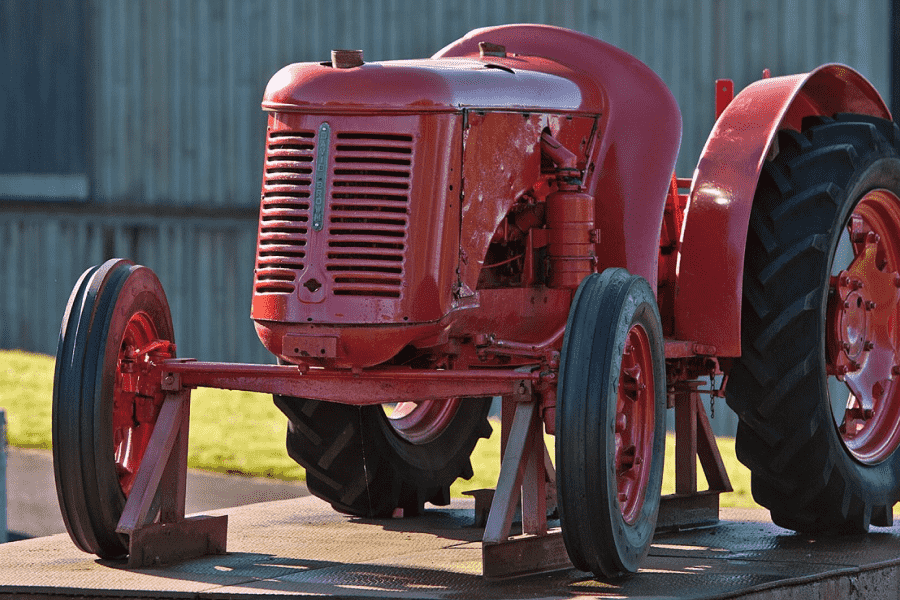Good morning everyone, and welcome to the Museum of Farming Life. I understand it's your first visit here, so I'd like to give you some background information about the museum and then explain a little about what you can see during your visit.
So, where we're standing at the moment is the entrance to a large building that was constructed in 1880 as the home of a local businessman, Alfred Palmer, of the Palmer biscuit factory. It was later sold and became a hall of residence for students in 1911, and a museum in 1951. In 2005, a modern extension was built to accommodate the museum's collections.
The museum's owned by the university, and apart from two rooms that are our offices, the university uses the main part of the building. You may see students going into the building for lessons, but it's not open to museum visitors, I'm afraid. It's a shame because the interior architectural features are outstanding, especially the room that used to be the library.
Luckily, we've managed to keep entry to the museum free. This includes access to all the galleries, outdoor areas and the rooms for special exhibitions. We run activities for children and students, such as the museum club, for which there's no charge. We do have a donation box just over there so feel free to give whatever amount you consider appropriate.
We do have a cloakroom, if you'd like to leave your coats and bags somewhere. Unlike other museums, photography is allowed here, so you might like to keep your cameras with you. You might be more comfortable not carrying around heavy rucksacks, though keep your coats and jackets on as it's quite cold in the museum garden today.
I'd like to tell you about the different areas of the museum.
Just inside, and outside the main gallery, we have an area called Four Seasons. Here you can watch a four-minute animation of a woodland scene. It was designed especially for the museum by a group of young people on a film studies course, and it's beautiful. Children absolutely love it, but then, so do adults.
The main gallery's called Town and Country. It includes a photographic collection of prize- winning sheep and shepherds. Leaving Town and Country, you enter Farmhouse Kitchen, which is... well, self-explanatory. Here we have the oldest collection of equipment for making butter and cheese in the country. And this morning, a specialist cheesemaker will be giving demonstrations of how it's produced. You may even get to try some.
After that, you can go in two directions. To the right is a staircase that takes you up to a landing from where you can look down on the galleries. To the left is a room called A Year on the Farm. There's lots of seating here as sometimes we use the room for school visits, so it's a good place to stop for a rest. If you're feeling competitive, you can take our memory test in which you answer questions about things you've seen in the museum.
The next area's called Wagon Walk. This contains farm carts from nearly every part of the country. It's surprising how much regional variation there was. Beside the carts are display boards with information about each one. The carts are old and fragile, so we ask you to keep your children close to you and ensure they don't climb on the carts.
From Wagon Walk, you can either make your way back to reception or go out into the garden – or even go back to take another look in the galleries. In the far corner of the garden is Bees are Magic, but we're redeveloping this area so you can't visit that at the moment. You can still buy our honey in the shop, though.
Finally, there's The Pond, which contains all kinds of interesting wildlife. There are baby ducks that are only a few days old, as well as tiny frogs. The Pond isn't deep and there's a fence around it, so it's perfectly safe for children.
 Thông tin mình cần nghe "Tòa nhà bảo tàng ban đầu là ?"
Thông tin mình cần nghe "Tòa nhà bảo tàng ban đầu là ?" Biết sắp có thông tin "I understand it's your first visit here, so I'd like to give you some background information about the museum and then explain a little about what you can see during your visit."
Biết sắp có thông tin "I understand it's your first visit here, so I'd like to give you some background information about the museum and then explain a little about what you can see during your visit." Nghe được "So, where we're standing at the moment is the entrance to a large building that was constructed in 1880 as the home of a local businessman, Alfred Palmer, of the Palmer biscuit factory"
Mình có:
a large building that was constructed in 1880 as the home of a local businessman
>> một tòa nhà lớn được xây dựng vào năm 1880 là nhà của một doanh nhân địa phương
= B. a private home.
Nghe được "So, where we're standing at the moment is the entrance to a large building that was constructed in 1880 as the home of a local businessman, Alfred Palmer, of the Palmer biscuit factory"
Mình có:
a large building that was constructed in 1880 as the home of a local businessman
>> một tòa nhà lớn được xây dựng vào năm 1880 là nhà của một doanh nhân địa phương
= B. a private home.  Đáp án: B
Đáp án: B

